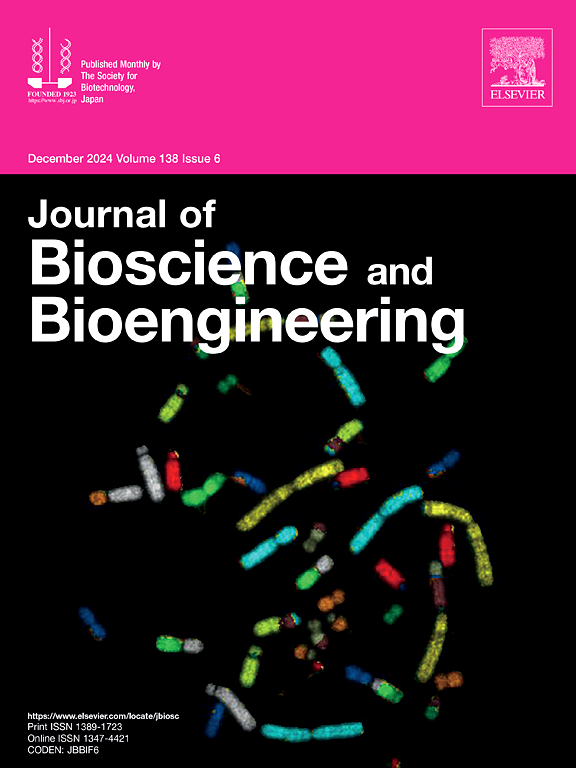Overproduction of secondary metabolites in Photorhabdus noenieputensis through rpoB mutations
IF 2.3
4区 生物学
Q3 BIOTECHNOLOGY & APPLIED MICROBIOLOGY
引用次数: 0
Abstract
Specific mutations of the rpoB gene, which encodes the β subunit of bacterial RNA polymerase, can enhance the production of secondary metabolites in bacteria such as actinomycetes. Entomopathogenic bacteria Photorhabdus and Xenorhabdus species produce a variety of secondary metabolites. Recently, these genera have attracted attention as a promising source for novel antibiotics. In this study, the effect of rpoB mutations on secondary metabolite production in Photorhabdus noenieputensis DSM 25462, a known producer of the antituberculosis antibiotic evybactin, was evaluated. Spontaneous rifampicin-resistant mutants, frequently carrying rpoB mutations, were generated by plating cells on agar medium containing four times the minimum inhibitory concentration (MIC) of rifampicin and evaluated their antibacterial production using Escherichia coli WO153 as a test strain. Among 190 spontaneous rifampicin-resistant mutants of P. noenieputensis, strain designated R191, which harbors the rpoB Q148K mutation (C442A), displayed higher antibacterial activity than that of the parental strain DSM 25462. The real-time quantitative RT-PCR analysis of 20 putative secondary metabolite biosynthetic gene clusters (BGCs) identified using antiSMASH revealed that seven of these BGCs were overexpressed in the strain R191. Furthermore, comparative high-pressure liquid chromatography (HPLC) analysis of the metabolite profile indicated that the strain R191 produced several compounds that were not detectable in the DSM 25462 culture. These findings suggest that the introduction of rpoB mutations into Photorhabdus strains is an effective strategy for enhancing secondary metabolite production and may lead to the discovery of novel antibiotics.
通过rpoB突变,noenieputensis次生代谢物过量产生。
编码细菌RNA聚合酶β亚基的rpoB基因的特异性突变可以增强放线菌等细菌次生代谢产物的产生。昆虫病原细菌Photorhabdus和Xenorhabdus产生多种次生代谢产物。最近,这些属作为新型抗生素的有希望的来源引起了人们的注意。本研究评估了rpoB突变对noenieputensis DSM 25462次生代谢物产生的影响,后者是一种已知的抗结核抗生素evybactin的生产者。将细胞置于含有4倍利福平最低抑菌浓度(MIC)的琼脂培养基上,产生自发的利福平耐药突变体,通常携带rpoB突变体,并以大肠杆菌WO153作为试验菌株评估其抑菌效果。在190株自发性耐利福平突变株中,携带rpoB Q148K突变(C442A)的菌株R191比亲本菌株DSM 25462表现出更高的抗菌活性。利用anti - smash对20个次生代谢产物生物合成基因簇(BGCs)进行实时定量RT-PCR分析,发现其中7个BGCs在菌株R191中过表达。此外,对比高压液相色谱(HPLC)分析表明,菌株R191产生了几种在DSM 25462培养物中未检测到的化合物。这些发现表明,将rpoB突变引入光habduus菌株是提高次生代谢产物产生的有效策略,并可能导致新抗生素的发现。
本文章由计算机程序翻译,如有差异,请以英文原文为准。
求助全文
约1分钟内获得全文
求助全文
来源期刊

Journal of bioscience and bioengineering
生物-生物工程与应用微生物
CiteScore
5.90
自引率
3.60%
发文量
144
审稿时长
51 days
期刊介绍:
The Journal of Bioscience and Bioengineering is a research journal publishing original full-length research papers, reviews, and Letters to the Editor. The Journal is devoted to the advancement and dissemination of knowledge concerning fermentation technology, biochemical engineering, food technology and microbiology.
 求助内容:
求助内容: 应助结果提醒方式:
应助结果提醒方式:


